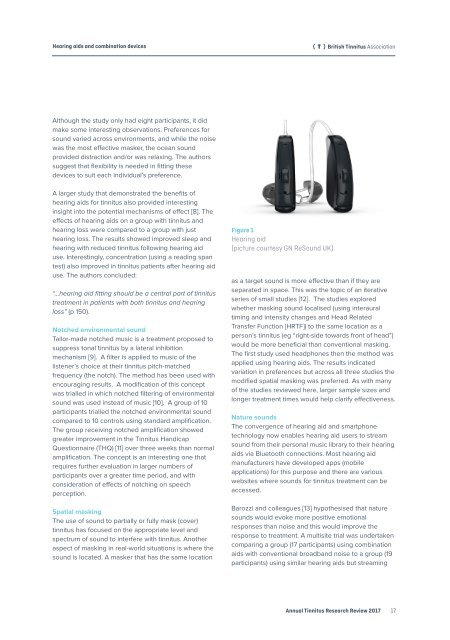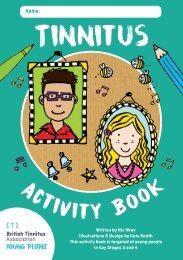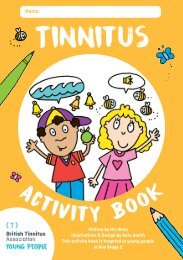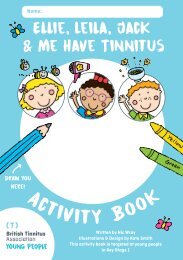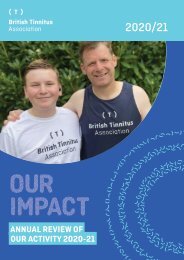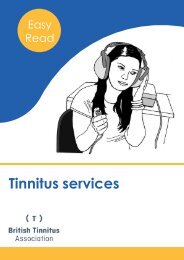Hearing Aids and Combination Devices
You also want an ePaper? Increase the reach of your titles
YUMPU automatically turns print PDFs into web optimized ePapers that Google loves.
<strong>Hearing</strong> aids <strong>and</strong> combination devices T British Tinnitus Association<br />
Although the study only had eight participants, it did<br />
make some interesting observations. Preferences for<br />
sound varied across environments, <strong>and</strong> while the noise<br />
was the most effective masker, the ocean sound<br />
provided distraction <strong>and</strong>/or was relaxing. The authors<br />
suggest that flexibility is needed in fitting these<br />
devices to suit each individual’s preference.<br />
A larger study that demonstrated the benefits of<br />
hearing aids for tinnitus also provided interesting<br />
insight into the potential mechanisms of effect [8]. The<br />
effects of hearing aids on a group with tinnitus <strong>and</strong><br />
hearing loss were compared to a group with just<br />
hearing loss. The results showed improved sleep <strong>and</strong><br />
hearing with reduced tinnitus following hearing aid<br />
use. Interestingly, concentration (using a reading span<br />
test) also improved in tinnitus patients after hearing aid<br />
use. The authors concluded:<br />
“…hearing aid fitting should be a central part of tinnitus<br />
treatment in patients with both tinnitus <strong>and</strong> hearing<br />
loss” (p 150).<br />
Notched environmental sound<br />
Tailor-made notched music is a treatment proposed to<br />
suppress tonal tinnitus by a lateral inhibition<br />
mechanism [9]. A filter is applied to music of the<br />
listener’s choice at their tinnitus pitch-matched<br />
frequency (the notch). The method has been used with<br />
encouraging results. A modification of this concept<br />
was trialled in which notched filtering of environmental<br />
sound was used instead of music [10]. A group of 10<br />
participants trialled the notched environmental sound<br />
compared to 10 controls using st<strong>and</strong>ard amplification.<br />
The group receiving notched amplification showed<br />
greater improvement in the Tinnitus H<strong>and</strong>icap<br />
Questionnaire (THQ) [11] over three weeks than normal<br />
amplification. The concept is an interesting one that<br />
requires further evaluation in larger numbers of<br />
participants over a greater time period, <strong>and</strong> with<br />
consideration of effects of notching on speech<br />
perception.<br />
Spatial masking<br />
The use of sound to partially or fully mask (cover)<br />
tinnitus has focused on the appropriate level <strong>and</strong><br />
spectrum of sound to interfere with tinnitus. Another<br />
aspect of masking in real-world situations is where the<br />
sound is located. A masker that has the same location<br />
Figure 1<br />
<strong>Hearing</strong> aid<br />
(picture courtesy GN ReSound UK)<br />
as a target sound is more effective than if they are<br />
separated in space. This was the topic of an iterative<br />
series of small studies [12]. The studies explored<br />
whether masking sound localised (using interaural<br />
timing <strong>and</strong> intensity changes <strong>and</strong> Head Related<br />
Transfer Function [HRTF]) to the same location as a<br />
person’s tinnitus (eg “right-side towards front of head”)<br />
would be more beneficial than conventional masking.<br />
The first study used headphones then the method was<br />
applied using hearing aids. The results indicated<br />
variation in preferences but across all three studies the<br />
modified spatial masking was preferred. As with many<br />
of the studies reviewed here, larger sample sizes <strong>and</strong><br />
longer treatment times would help clarify effectiveness.<br />
Nature sounds<br />
The convergence of hearing aid <strong>and</strong> smartphone<br />
technology now enables hearing aid users to stream<br />
sound from their personal music library to their hearing<br />
aids via Bluetooth connections. Most hearing aid<br />
manufacturers have developed apps (mobile<br />
applications) for this purpose <strong>and</strong> there are various<br />
websites where sounds for tinnitus treatment can be<br />
accessed.<br />
Barozzi <strong>and</strong> colleagues [13] hypothesised that nature<br />
sounds would evoke more positive emotional<br />
responses than noise <strong>and</strong> this would improve the<br />
response to treatment. A multisite trial was undertaken<br />
comparing a group (17 participants) using combination<br />
aids with conventional broadb<strong>and</strong> noise to a group (19<br />
participants) using similar hearing aids but streaming<br />
Annual Tinnitus Research Review 2017<br />
17


